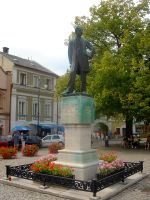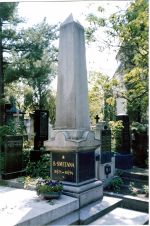Bedřich Smetana
Bedřich Smetana March 2, 1824 - 12 May 12, 1884) is considered one of the greatest Czech composers of the 19th century and the country's first nationalist composer. He is best known for his symphonic poem Vltava (The Moldau), the second in a cycle of six which he entitled Má vlast (My Country).part of the Austrian Empire
Life
Early Years
Bedrich Smetana was born as the seventh child of a fairly wealthy man from the third marriage of Master Brewer Frantisek Smetana to Barbora Linkova. The family was constantly on the move, and young Bedrich went to high school in Jindrichuv Hradec, Jihlava, Havlickuv Brod, Prague and Plzen, where he graduated. Although he is the Czech Republic's national composer and wrote several operas in Czech, as a child he was not taught the language. From a very early age he showed a great talent for music, which was encouraged within the family, and he played the piano at his first concert at the age of eight. Throughout his childhood, he also performed in a quartet at home, playing first violin, and his father second, although his father opposed to his son's formal musical training.
A deciding factor in his artistic development was studying under Josef Proksch in Prague, from 1843. Then he moved to Prague to study piano and theory with J. B. Kittl, director of the Prague Conservatory. After completing his studies, he worked four years as a music teahcer for the family of hte famous Count Thun. Then he founded his own private piano school in Prague, with the help of Franz Liszt, and began composing, and a year later married his teenage love Katerina Kolarova, a fine pianist.
Family Tragedies
The 1840s and 1850s were turbulent years in the life of his nation, of Europe, and his personal life, with European nationalist movements of 1848, political oppression, and the death of his second child, his beloved four-year-old daughter Bedřiska, coupled with his inability to establish himself on his home turf. When his third child died nine months later, he committed himself to composition, producing the Piano Trio in G minor. This piece is full of sadness and despair, making use of phrases that are cut short, possibly in resemblance to his daughter's own life.
Sweden
In an attempt to escape a place where everything reminded him of the loss of his daughter, Smetana decided to leave Bohemia, and in 1856 he moved to Goteborg, Sweden. Here he taught, conducted Sweden's Philharmonic Society, and gave chamber music recitals for five years. He achieved recognistion for his conducting, piano playing, and compositions. However, the northern climate accelerated Katerina's illness and she died in 1859. A year later he married again to the 20-year-old Bettina Ferdinandiova.
Back Home
After the easing of the political situation in the Czech lands, he hurried home,He did not settle in Prague permanently at first, and spent his time travelling back and forth to Gothenburg, before making Prague his home in 1863. In 1863, back in Prague, he opened a new school of music dedicated to promoting specifically Czech music. During this time, he composed his historical opera The Brandenburgers in Bohemia, whose first performance in 1864 was an instant success. This was followed in 1866 by perhaps his most famous opera, the comedy The Bartered Bride. The Bartered Bride was an instant and enduring success. It was in the same year that Smetana became a conductor at the Provisional Theatre, the first theatre in Prague to hold performances in Czech, , where he focused primarily on opera. The opera emerged from his awareness of his responsibility to his nation, and his firm belief in its future. He held this position until he went deaf in 1874 as a result of a long illness. Despite his catastrophe he managed to realize his long-held creative project: to celebrate his homeland and nation with a cycle of symphonic poems.
From 1875 he lived in small village of Jabkenice. As if plain deafness were not enough, Smetana also suffered from tinnitus, which caused him to hear a continuous, maddening high note which he described as the "shrill whistle of a first inversion chord of A-flat in the highest register of the piccolo. "Towards the end of the 1870s, Smetana's health continued to fail, and in 1883 he apparently suffered a mental breakdown, and was placed in a mental asylum in Prague, where he died shortly after his sixtieth birthday, on May 12th 1884. It is widely believed that in actual fact he died of syphilis.
Compositions
His first compositions included pieces for the piano, such as waltzes, bagatelles, and impromptus. But in 1863 he finished the singspiel Branibory v Cechach (Brandenburgers in Bohemia,with a libretto by Karel Sabina), which was a great success - and brought its author some much-needed finances. Described as a Bohemian rebellion against Teutonic invaders, the music is strongly Wagnerian but the Bohemian folk songs and dances are perceptible in it. Wiht the next three opearas—The Bartered Bride, Dalibor and LIbuse—he set the tone of Bohemia's musical theater.
Bohemian folk music was dominant also in his concert works, particularly the six-part My Fatherland, whose Vltava (The Moldau) is universally admited, and in his two autobiagraphical quartets From My Life. Pitts Sanborn said of The Bartered Bride that it is not folk music "in a crapming sense. While distinctively of its native soil... [this music] possesses the universal qualities necessary to give it a world-wide currency. We of other countries delight in Czech rhythms, its national dances, the characteristic contour of its melodies, but we also find in this music more than local color and exotci charm; the flowing humanity is there that transcends limits and boundaries." (ref Ewen 775)
Jan Lowenbach added that "Smetana was privileged not only to hear ad imitate the spirit of the rich melodies and varied rhythms of his nation, but also to invent, to feel,a nd to express it in a new way and to adapt it to the spirit of modern times." (Ewen 775)
Amongst the many compositions from this period were Ma Vlast, My Homeland, possibly Smetana's best known piece, a set of symphonic poems which evoked the beauty of the Czech countryside, plus the opera The Kiss, and a piece called The Czech Dances. in general his works were well received during his lifetime, with a few exceptions, such as his tragic opera Dalibor, written in 1867, which was heavily criticised.
The peak of his production from this period is his Klavirni trio g moll (1855) (Piano trio in g minor), which reflected his grief over the loss of Bedriska.
Smetana was a great admirer of Franz Liszt, and they were in frequent contact through correspondence and personal meetings. He was gripped by Liszt's idea of the symphonic poem. This gave rise to such works as his Richard III., Valdstynuv tabor (Waldstein's Camp) and Hakon Jarl. although things did not immediately go well for him. He completed Prodana nevesta (The Bartered Bride) in 1866 and conducted it himself.
His string quartet in E minor, Z mého života (From My Life, composed in 1876), the first of only two quartets, is an autobiographical work. The final movement is punctuated by a piercing high E in the first violin which, Smetana explained, represents the devastating effects of his tinnitus. He may also be hinting at this personal misfortune with the piccolo scoring in Má vlast. In 1883 Smetana, suffering further progressive neurological effects of his illness, finally became insane, and was taken to a mental hospital in Prague, where he died the following year. He is interred in the Vyšehrad cemetery in Prague.
Smetana is noted as being the first composer to write music that was specifically Czech in character. Many of his operas are based on Czech themes and myths, the best known being the comedy The Bartered Bride (1866). He used many Czech dance rhythms and his melodies sometimes resemble folk songs. He was a great influence on Antonín Dvořák, who similarly used Czech themes in his works.
Czech Music of the Romantic Era
This period saw the advance of the National Revival in the Czech Lands. The greatest display of these revivalist tendencies in the spirit of Romanticism appeared primarily in Czech opera, which was a blend of European influences. In opera it imitated the Italians,a nd in symphonies and chamber music it echoed the styles of German and Austrian masters. In the second part of the 19th century, Europe was flooded by nationalism, which spurred patirotism and national consciousness and the serach for a national art. In 1862, the national theater was founded, financed with donations from rich and poor alike. The theater served as a platform for staging Czech drama and operas. Smetana's first opera, The Brandenbrugers in Bohemia, was written for it.
Works
Operas
- Braniboři v Čechách (Brandenburgers in Bohemia) 1863
- Prodaná nevěsta (The Bartered Bride) 1866
- Dalibor 1867
- Libuše 1872
- Dvě vdovy (The Two Widows) 1873
- Hubička (The Kiss) 1876
- Tajemství (The Secret)
- Čertova stěna (The Devil's Wall)
- Viola (not completed) 1884
Other
Cycle of symphonic poems Ma vlast (My Fatherland) 1874-1879:
- Vysehrad
- Vltava:
- Sarka
- Z ceskych luhu a haju (From Czech Fields and Groves)
- Tabor
- Blanik
- String quartet From my Life 1876
- Quartet Bohemian Dances
- Tone Poem Wallensteins Lager (1859)
Notes
External Links
- The Composers of Bohemia
- Free Public Domain Sheet Music by Smetana at IMSLP
- http://www.radio.cz/en/html/hudba_romantismus.html
- http://www.radio.cz/en/article/37465
ReferencesISBN links support NWE through referral fees
- Jiří Ramba: Slavné české lebky, antropologicko-lékařské nálezy jako pomocníci historie (Famous Czech Skulls, anthropological-medical findings as helpers of history), Galén, 2005, Prague, ISBN 80-7262-325-7
Credits
New World Encyclopedia writers and editors rewrote and completed the Wikipedia article in accordance with New World Encyclopedia standards. This article abides by terms of the Creative Commons CC-by-sa 3.0 License (CC-by-sa), which may be used and disseminated with proper attribution. Credit is due under the terms of this license that can reference both the New World Encyclopedia contributors and the selfless volunteer contributors of the Wikimedia Foundation. To cite this article click here for a list of acceptable citing formats.The history of earlier contributions by wikipedians is accessible to researchers here:
The history of this article since it was imported to New World Encyclopedia:
Note: Some restrictions may apply to use of individual images which are separately licensed.

